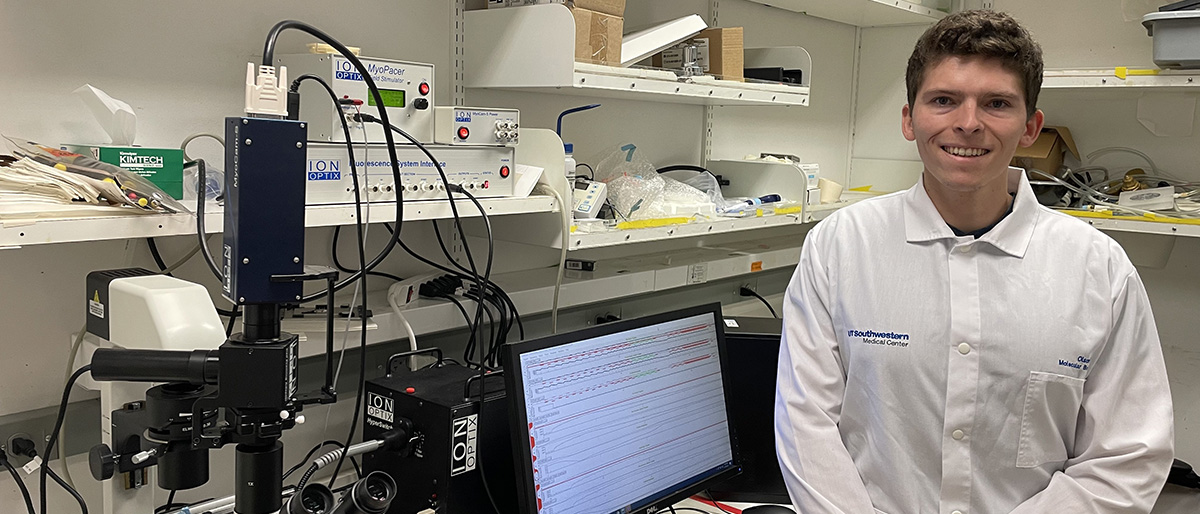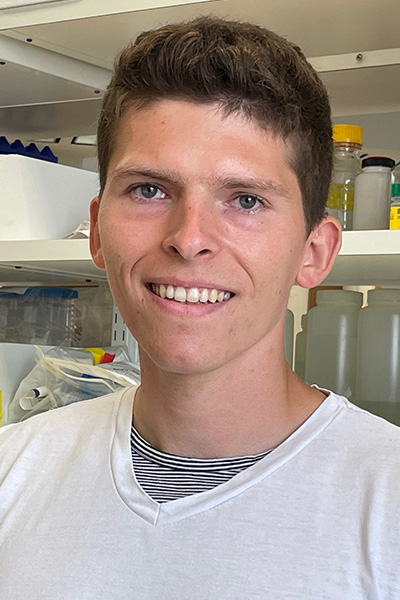Former postdoc earns Brown-Goldstein Award for gene editing cardiology work

Cardiovascular disease, especially following a heart attack, is the No. 1 cause of death worldwide. Pharmaceutical strategies can improve heart function after damage, but they may have drawbacks that include lack of efficacy and negative impact to cells and tissues outside the heart.
Work over the last three years led by Simon Lebek, M.D., a former postdoctoral fellow in the laboratory of Eric Olson, Ph.D., and Rhonda Bassel-Duby, Ph.D., could offer a promising solution: disrupting pathological signaling to improve cardiac function through gene editing. This research recently earned Dr. Lebek the Brown-Goldstein Award for Excellence in Postdoctoral Research, given annually by the UT Southwestern Graduate School of Biomedical Sciences in honor of the contributions of UTSW Nobel Laureates Michael Brown, M.D., and Joseph Goldstein, M.D., to training future scientists.

Accompanied by a $6,000 prize and the opportunity to present a University Lecture, the award represents the highest recognition the Graduate School bestows on postdoctoral trainees.
“Simon’s findings have important implications for the treatment of heart disease and open opportunities for modulation of other disease-causing pathways through highly specific gene editing approaches. I am especially proud of Simon’s achievements and excited about his future,” said Dr. Olson, Chair of Molecular Biology and Dr. Lebek’s mentor. Dr. Olson also directs the Hamon Center for Regenerative Science and Medicine and the Senator Paul D. Wellstone Muscular Dystrophy Cooperative Research Center.
Dr. Lebek got his start in cardiology research while attending medical school at the University Hospital Regensburg in Germany. Today, he is an Associate Professor of Internal Medicine and Cardiology at the same hospital, close to the area where he and his younger brother and sister grew up. They often heard their father and grandfather – both physicians – discussing interesting cases, and as a result, all three siblings decided to become physicians themselves.
Sparked by a fascination with the heart’s role in the body, Dr. Lebek pursued cardiology training. He learned about interventions for cardiac disorders and the dearth of treatment options for some of these conditions, spurring a drive to develop better therapies through research. Toward that end, he approached Lars Maier, M.D., a clinician-scientist who chairs the University Hospital Regensburg’s Department of Cardiology and directs cardiology research at the University of Regensburg.
During his doctoral studies in Dr. Maier’s laboratory, Dr. Lebek identified molecular links between sleep apnea and its associated arrhythmias. Moreover, he realized that conventional compound-based therapies have significant limitations that often prevent further development of a drug toward potential translation into the clinic.
Searching for a way to develop an advanced therapeutic concept, Dr. Lebek reached out to Dr. Olson, a global expert on the stress-response pathways that underlie pathological cardiac remodeling as well as gene editing using CRISPR-Cas9 technology, a tool that acts like a molecular pen to modify specific portions of DNA, fine-tuning target genes.
After the two talked, Dr. Olson offered Dr. Lebek a postdoctoral position. Usually, CRISPR-Cas9 gene editing is deployed to correct rare hereditary mutations, which precludes broad application. Drs. Lebek and Olson reasoned that gene editing could be used to disrupt common pathogenic signaling cascades, which may overcome the limitations of conventional pharmaceutical approaches. It would also offer a “one and done” treatment, since gene editing induces a permanent alteration in the adult heart. Just over two months after their initial conversation, Dr. Lebek and his wife, Juliane, were on a flight to Dallas, where they would live for the next three years while he completed his postdoctoral fellowship.
Dr. Lebek’s research quickly progressed, leading to successful gene editing in human myocardial cells and mouse models. Over a decade ago, the Olson lab demonstrated for the first time the central role of CaMKIIδ in cardiac disease. Their findings now showed that editing the gene for this stress-responsive enzyme helped restore cardiac function in various mouse models, including conditions like heart attack and heart failure. These findings were published in several top-tier scientific journals, including Science, Circulation, and The Journal of Clinical Investigation.
“Simon is a forward-thinking young scientist with a great future ahead. His research shows his devotion to understanding the biological underpinnings of cardiac disease, as well as developing new therapies for his heart failure patients,” said Dr. Bassel-Duby, Professor of Molecular Biology.
These successes encouraged Dr. Lebek to apply for and ultimately win a Heisenberg Professorship, a highly competitive program sponsored by the German Research Foundation that provides funding and other resources to streamline promising young researchers’ pathways to becoming full professors. After accepting a job offer at his alma mater, the University of Regensburg, he won other grants that allowed him to hire lab personnel. He began purchasing equipment for his new lab and working with those personnel to plan experiments even before he left Dallas in November.
In his new position, Dr. Lebek intends to continue to work toward identifying promising targets to treat a variety of cardiovascular conditions while also seeing patients in the University Hospital Regensburg.
“My dream is to become a successful clinician-scientist, with my lab work informed by my cardiac patients and their treatments informed by my lab work,” Dr. Lebek said.
Dr. Brown, a Regental Professor, holds The W.A. (Monty) Moncrief Distinguished Chair in Cholesterol and Arteriosclerosis Research, and the Paul J. Thomas Chair in Medicine.
Dr. Goldstein, a Regental Professor, holds the Julie and Louis A. Beecherl, Jr. Distinguished Chair in Biomedical Research, and the Paul J. Thomas Chair in Medicine.
Dr. Olson holds the Pogue Distinguished Chair in Research on Cardiac Birth Defects, The Robert A. Welch Distinguished Chair in Science, and the Annie and Willie Nelson Professorship in Stem Cell Research.

